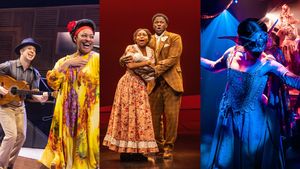CONTACTAbout UsCAREER OPPORTUNITIESADVERTISE WITH USPRIVACY POLICYPRIVACY PREFERENCESTERMS OF USELEGAL NOTICE
© 2025 Equal Entertainment LLC.
All Rights reserved
All Rights reserved
By continuing to use our site, you agree to our Privacy Policy and Terms of Use.
We need your help
Your support makes The Advocate's original LGBTQ+ reporting possible. Become a member today to help us continue this work.
Your support makes The Advocate's original LGBTQ+ reporting possible. Become a member today to help us continue this work.
South Florida held the global spotlight in the early 1990s, boasting not one but two major gay cities on the rise. Less than 30 minutes apart, Miami and Fort Lauderdale initially surfaced as mutually exclusive entities, catering to discrete demographics. Miami Beach--no longer a straight retirement community--satisfied the hunger for the glamorous and the vanguard, luring in global party boys, hipsters, and scene queens for a world-renowned party scene. Fort Lauderdale welcomed middle-aged gays seeking sunny refuge from socially intolerant "red states." The media hyped Miami's fashion and the influx of cash from a wealthy Latin American expat population, while Fort Lauderdale--busy scrubbing away its 1980s-tinged Pabst Blue Ribbon party image--offered casual, affordable beachfront living. The crossover was minimal--either you were a Miami gay or a Lauderdale gay, and rarely the twain did meet.
Then, at the dawn of the millennium, these companionate cities became dueling divas in a vicious tug-of-war for the gay dollar. After reinvigorating the city of Miami Beach (also called South Beach, it's a municipality distinct from Miami proper) and pushing the elderly upward to North Miami Beach and Hallandale, Miami's gays found themselves priced out of town. The once-again chic South Beach was prohibitively expensive for those with hourly incomes, and wealthy straight couples replaced the younger retail queens and restaurant servers. As the mainstream swallowed the iconoclastic, South Beach fell out of favor in the fickle world of trends and trendsetters. Soon came the end of such megaclubs as Warsaw, Pump, Amnesia, and Salvation; Miami had lost its luster as a global party destination. Those tired of the dwindling scene and the pretension longed to escape the confines of South Beach, and gays realized that beyond the borders of Alton Road and Ocean Drive, they had little influence or even presence in the rest of Miami.
Twenty-five miles north, Fort Lauderdale was in the process of a $2 billion face-lift designed to promote urban economic development (and to clean up the Aqua Net oil slick left from the spring break era). Capitalizing on the beauty of the labyrinthine Intracoastal Waterway, the city was rechristened the "Venice of America," a home for the world's fastest-growing yachting community, with turquoise beaches that rival the Caribbean and a progressive, gay-friendly atmosphere on par with San Francisco's.
Dozens of new nightlife options emerged throughout Fort Lauderdale. Some, such as the high-tech dance palace Coliseum, reinvented the gay Miami party scene of 1999, with world-famous DJs, drag extravaganzas, and easily accessible party drugs. Other venues, such as the Jackhammer and the Ramrod, catered to the leather subculture, providing an open forum for chaps and straps. The Moulin Rouge-inspired China White emerged as gay Fort Lauderdale's Studio 54 at the height of the real estate boom in 2006. The gay scene was not confined to just one neighborhood but took root in three distinct cities within greater Fort Lauderdale: Wilton Manors, Oakland Park, and Fort Lauderdale proper. Chic, urban high-rises were erected along Las Olas Boulevard for the city's new bourgeoisie. Luxurious hotels such as the W and the Ritz-Carlton replaced former dilapidated dumps along the beach. Suburban homes were relandscaped, repainted and remodeled. Fort Lauderdale became a place where gays of all genders, shapes, sizes, and ages could bask in their preferences. It seemed as though Miami had been permanently replaced as South Florida's gay playground.
But Fort Lauderdale's rapid move up the gay social ladder hit a major stumbling block in 2008 when the investment bubble burst and real estate prices plummeted in tandem with failing global markets. Meanwhile, the same fate hit Miami, leaving many shiny new buildings tenant-free. A more affordable South Beach caught the queer eye and renewed interest in the mystique and contemporary architecture that put the city on the map in the 1930s. With foreclosures beckoning and equities dwindling, South Beach housing prices fell to premillennium levels. Faced with recession anxiety, locales and establishments previously sanctioned for the rich and famous reached out to the masses. Exclusive hotels such as the Raleigh and the Standard halved their rates. High-end restaurants lowered their prices. More nightclubs granted free entry and added nightly drink specials to the menu. Economic downturn had become a traveler's and buyer's opportunity for the recently inaccessible and overpriced.
Though the gays had been crowded out for nearly a decade, South Beach remained famous to the world at large for its celeb-favored hotels, renowned restaurants, and lively beaches crammed with hard bodies sporting chic sunglasses and fierce Speedos. Each year more international visitors arrived to sample the custom-designed pools, decked-out rooftops, meticulously chosen color schemes, and the individualistic themes of the beach's art deco treasures. An expansion project launched by the city and eager investors during the boom times yielded billion-dollar restorations (the Fontainebleau), condo-hotel combinations (the Gansevoort), and high-end designers living out their fantasies through their work (the Mondrian South Beach). A remixed and refreshed landscape showcased masterpieces of internationally renowned architects and designers. Unfortunately for businesses but fortunately for consumers, poor timing of this project resulted in an ultra avant-garde South Beach with two-star price points and extraordinary real estate opportunities.
This financial phenomenon has brought the gays back to their old South Beach stomping grounds after a few years in exile. Miami's cultural scene has continued apace, hosting international events such as Art Basel Miami Beach, now one of the world's most important contemporary art shows. And despite the decentralization of the circuit scene, international megaparties rock South Beach year after year, with global hotties congregating for the White Party, Winter Party, and Aqua Girl.
Back north of the Miami-Dade/Broward county line, Fort Lauderdale's economic survival of the fittest in the past two years left the weakest of the restaurants, clubs, and accommodations to fade away. Since then, Fort Lauderdale has returned to its unfussy roots. The city's forced micro-induction of metropolitan sophistication goes no further than the few luxury beach hotels and a handful of upscale eateries. Wilton Manors, the official gayborhood, has flourished with dozens of quaint gay novelty shops, colossal neighborhood bars that reach capacity with cheap nightly drink specials, and mismatched architecture.
Fort Lauderdale has prospered as a destination for singles and couples in search of middle-class gay utopia with a small-town feel. The scene, the stores, and the lifestyle cater to an over-40 crowd, significantly less concerned with trends than neighboring Miami. Fort Lauderdale remains very much a beach town, where it is acceptable to wear a tank top and flip-flops to restaurants and bars. The "come as you are" philosophy defines everyday life.
Through their race to become gay belle of the ball, Miami and Fort Lauderdale inadvertently lost their mutual exclusivity, and it actually seems that the former rivals have finally found equilibrium. It's common now for residents and visitors to split their time between the two cities. Regular visits between the two are welcome reprieves for those seeking a break from a home turf. The fine line between proximity and distance keeps things fresh and fun for residents on both sides of the county border. The largely vanquished spring break scene notwithstanding, visitors still flock to Fort Lauderdale from the far corners of the nation in search of the same simple combination that made the city famous: sun, fun, sex, and booze. Most prefer to stay at one of the 30 clothing-optional gay bed-and-breakfasts rather than massive new hotels, all minutes from Sebastian Beach. In contrast to SoBe's "Muscle Beach" reputation, Sebastian Beach finds itself the Cheers of South Florida beaches--friendly and relaxed, stripped and raw, with all ages and sizes, from twinks to porn stars to leather daddies to bears. After the beach, the city's younger adults and elders indulge in a hedonistic cocktail of sex, alcohol, and dance remixes along Wilton Drive.
Whereas Fort Lauderdale brings together people from all over the United States, Miami unites nations and varied cultures, lending to a remarkable diversity and cosmopolitan feel. The legacy of immigration waves from the 1970s onward endures, and Spanish and Creole are spoken alongside English. While the nightlife scene is significantly smaller than at Miami's peak (think Madonna and Versace in the 1990s) a few gay strongholds such as Score, Twist, Mova (formerly Halo), and Buck 15 remain steadfast in defense of their territory. And there's still no shortage of flash. Well-dressed Europeans and worldly globetrotters strut South Beach's Lincoln Road catwalk, outflaunting one another in designer jeans, chunky glasses, exclusive T-shirts, and posh trimmings.
Politically, both stand as liberal pockets in a state ironically all too familiar with the iron fist of discrimination, recently tightened by constitutional bans on civil unions and same-sex marriages. Socially, each city has attracted its own eclectic following. Gone are the days of relentlessly trying to outshine one another and prove homosexual dominance. Now, Miami and Fort Lauderdale are proudly distinct arenas for indulging, ignoring surgeon generals' warnings, or cultivating a mainstream gay life. The sun shines equally bright on South Beach and Sebastian Beach.
From our Sponsors
Most Popular
Bizarre Epstein files reference to Trump, Putin, and oral sex with ‘Bubba’ draws scrutiny in Congress
November 14 2025 4:08 PM
True
Jeffrey Epstein’s brother says the ‘Bubba’ mentioned in Trump oral sex email is not Bill Clinton
November 16 2025 9:15 AM
True
Watch Now: Pride Today
Latest Stories
Here are the best shows on and off-Broadway of 2025
December 26 2025 7:00 AM
10 of the sexiest music videos that gagged everyone in 2025
December 25 2025 9:30 AM
Far-right, anti-LGBTQ+ Project 2025 will continue into 2026
December 24 2025 6:34 PM
Democratic officials sue RFK Jr. over attempt to limit gender-affirming care for trans youth
December 24 2025 4:30 PM
Heated Rivalry season 2: Everything we know so far
December 24 2025 3:30 PM
Who is Lillian Bonsignore — set to be first out gay Fire Department of New York commissioner?
December 23 2025 6:21 PM
True
The HIV response on a cliff-edge: advocacy must drive urgent action to end the epidemic
December 23 2025 2:23 PM
CECOT story pulled by Bari Weiss gets viewed anyway thanks to Canadian streaming service
December 23 2025 2:05 PM
Burkina Faso issues first sentence for 'homosexuality and related practices'
December 23 2025 2:02 PM
Transgender NSA employee files discrimination lawsuit against Trump administration
December 23 2025 12:03 PM
Billy Porter is set to make a 'full recovery' from sepsis
December 23 2025 11:54 AM
Soccer stars Rafaelle Souza and Halie Mace are engaged & the video is so adorable
December 23 2025 10:52 AM




































































Charlie Kirk DID say stoning gay people was the 'perfect law' — and these other heinous quotes